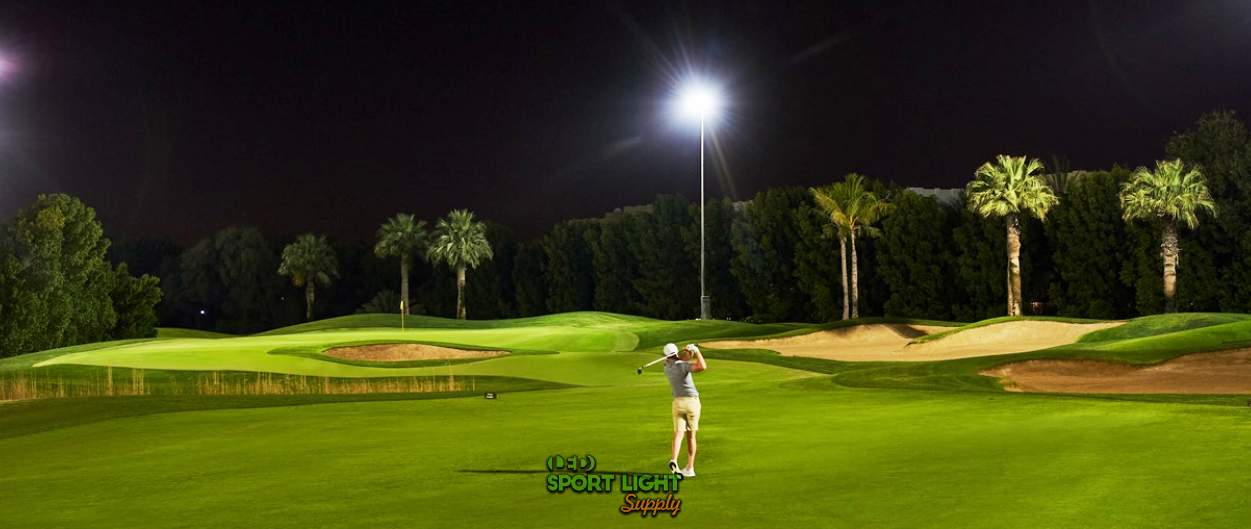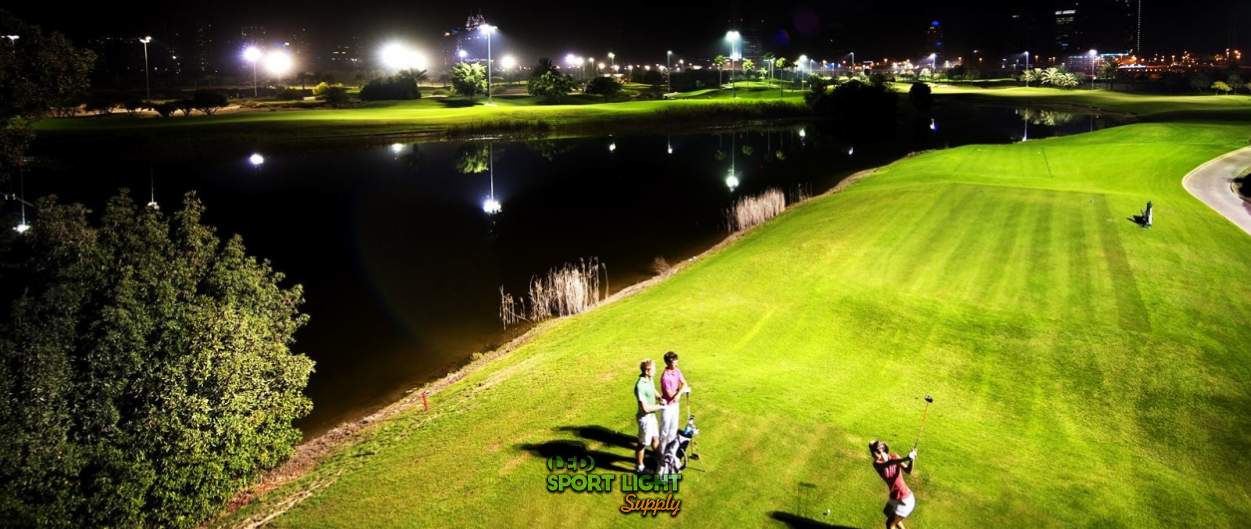As golf courses continue to evolve, particularly with the integration of LED technology, understanding the complexities of lighting design becomes essential.
LED lighting has transformed golf course illumination by offering superior energy efficiency, longevity, and lower maintenance compared to traditional systems. LEDs ensure consistent performance while minimizing energy use, making them ideal for balancing functionality and environmental impact on golf courses. Their high-quality illumination reduces glare, enhances the player’s experience, and provides excellent color rendering, crucial for distinguishing shades of green on the course.

Table of Contents
ToggleDesigning a golf course lighting system involves several critical decisions, including the selection and positioning of fixtures. The choice of LED fixtures is crucial, as these lights are specifically engineered to handle the demands of sports lighting. High-quality LEDs offer precise control over light distribution, which helps reduce glare and improve visibility. Additionally, the placement of fixtures must be meticulously planned to achieve the desired lighting effects. This involves calculating the optimal distances between fixtures and ensuring that their light patterns overlap appropriately to avoid gaps in coverage.
The height and placement of light poles play a significant role in the effectiveness of a golf course lighting system. Poles that are too short may not provide sufficient illumination, while those that are too tall can create excessive glare. For most golf courses, light poles are typically installed at heights ranging from 30 to 50 feet. This height range strikes a balance between providing broad coverage and minimizing glare. The spacing of the poles is also a critical factor, as it affects the uniformity of light distribution. Proper spacing ensures that the light patterns from different poles overlap, eliminating shadows and providing consistent illumination across the course.
Achieving Uniform Illumination
Uniform illumination is essential for a high-quality golf course lighting system. The goal is to provide even lighting across the entire course, ensuring that no areas are left in shadow or overly bright. Uneven lighting can disrupt gameplay by creating glare or dark spots, which can affect a golfer’s performance and enjoyment. To achieve this uniformity, high-quality LED fixtures designed specifically for sports applications are employed. These fixtures feature advanced optics that distribute light evenly, minimizing hotspots and shadows. Strategic placement of these fixtures is critical; they must be positioned to overlap light patterns effectively, ensuring that the entire playing area is covered without creating undesirable lighting effects.
Comprehensive Coverage
Effective lighting coverage extends beyond merely illuminating the fairways and greens. A well-designed lighting system must also ensure that hazards, bunkers, and tee boxes are adequately lit. Proper coverage is essential for maintaining safety and enhancing the playability of the course. This requires a comprehensive lighting design that takes into account not just the primary playing areas but also the surrounding landscape. By illuminating key features and ensuring that all areas are visible, golf courses can provide a safer and more enjoyable experience for players, even as darkness falls.
Color temperature is an important consideration in golf course lighting design. LED lights come in a range of color temperatures, from warm white to cool white. For golf courses, a cooler color temperature, typically between 4000K and 6000K, is often preferred. Cooler temperatures provide clearer and more natural light, which enhances visibility and reduces eye strain for golfers. The right color temperature can also affect the aesthetic appeal of the course, highlighting its features and creating a more inviting atmosphere for players.

One of the most significant advantages of LED lighting is its energy efficiency. LEDs consume considerably less power compared to traditional lighting technologies, resulting in lower energy bills and a reduced environmental impact. To further optimize energy consumption, smart lighting controls can be implemented. These controls allow for automatic adjustments of light levels based on ambient conditions and time of day. For example, lighting levels can be dimmed during periods of low activity, conserving energy while still maintaining adequate illumination for those using the course.
Sustainability is a key consideration in modern golf course lighting design. By utilizing energy-efficient LED lights and integrating solar-powered fixtures, golf courses can significantly reduce their environmental footprint. Solar lighting, in particular, offers an eco-friendly alternative to grid-powered lighting, harnessing renewable energy to provide illumination. Additionally, incorporating smart controls and scheduling can help manage energy use more effectively, further enhancing the sustainability of the lighting system. These practices not only benefit the environment but also contribute to the course’s reputation as a responsible and forward-thinking facility.
Replacing outdated lighting fixtures with modern LED alternatives offers numerous benefits, including improved light quality and reduced energy consumption. New LED fixtures provide better brightness, superior color rendering, and more precise control over light distribution compared to older technologies. These improvements can enhance both the functionality and aesthetics of the golf course. Additionally, LED lights have a longer lifespan, which reduces the frequency of replacements and associated maintenance costs. Upgrading to LEDs can significantly improve the overall lighting experience for golfers and contribute to a more efficient and effective lighting system.
Incorporating advanced lighting controls during replacement projects can further optimize the performance of the lighting system. Smart controls can adjust lighting levels in real-time based on environmental conditions and usage patterns. This allows for more precise management of energy consumption and ensures that lighting is always appropriate for the conditions. For example, the system can automatically dim lights during periods of low activity or bright sunlight, reducing energy use without compromising visibility. Upgrading to these advanced controls can enhance the overall quality of the lighting system and contribute to long-term cost savings.
Solar lighting presents an eco-friendly alternative to traditional grid-powered lighting solutions. By harnessing solar energy, these systems reduce reliance on electricity from the grid, leading to lower energy costs and a smaller environmental footprint. Solar lighting is particularly beneficial for non-essential areas such as pathways, signage, and parking lots. These areas often require less intense lighting and can be effectively illuminated with solar-powered fixtures. The use of solar lighting aligns with sustainable practices and can enhance the golf course’s reputation as an environmentally responsible facility.
When installing solar lighting, it is crucial to assess the site’s solar exposure and ensure that solar panels receive adequate sunlight. Factors such as shading from trees, buildings, and other obstacles can affect the efficiency of solar panels and impact the performance of the lighting system. Additionally, the design should account for seasonal variations in sunlight to ensure that the system meets the required performance standards throughout the year. Proper planning and site assessment are essential to maximize the benefits of solar lighting and ensure that it effectively complements the overall lighting strategy for the golf course.
Understanding the costs associated with golf course lighting is essential for effective budgeting and financial planning. The initial installation cost includes the purchase of fixtures, poles, wiring, and installation labor. LED systems generally have a higher upfront cost compared to traditional lighting solutions. However, this higher initial investment is offset by the long-term savings in energy and maintenance. The durability and efficiency of LED lights contribute to a lower total cost of ownership over time, making them a cost-effective choice in the long run.
Ongoing energy expenses are a significant factor in the total cost of golf course lighting. LED lights are more energy-efficient than traditional lighting options, leading to reduced electricity bills. Additionally, smart controls and scheduling can further optimize energy consumption, resulting in additional cost savings. By carefully managing energy use and implementing strategies to reduce consumption, golf courses can achieve substantial savings on their lighting expenses while maintaining high-quality illumination.
While LEDs require less frequent replacement compared to traditional lighting technologies, regular maintenance is still necessary to ensure optimal performance. Maintenance costs include cleaning fixtures, inspecting poles, and addressing any issues that arise. The longer lifespan and durability of LED lights contribute to lower long-term maintenance expenses. By investing in high-quality fixtures and implementing a proactive maintenance schedule, golf courses can minimize downtime and ensure that their lighting systems continue to operate efficiently.
Golf course lighting not only serves functional purposes but also plays a significant role in enhancing the visual appeal of the course. Creative lighting design can highlight architectural features, water hazards, and other landscape elements. Techniques such as uplighting can illuminate trees and structures, creating dramatic visual effects that enhance the course’s aesthetic appeal. Additionally, colored LED lights can be used for special events or tournaments to create unique atmospheres and add to the overall experience for golfers and spectators.
While enhancing the visual appeal of the course, it is also important to minimize light pollution. Properly designed lighting systems should focus light where it is needed and reduce spillover into surrounding areas. This helps preserve the natural beauty of the environment and minimizes the impact on nearby residents. By using well-designed fixtures and implementing strategies to control light spill, golf courses can achieve the desired illumination while maintaining a balance with environmental considerations.
Safety is a critical aspect of golf course lighting. Adequate illumination ensures that golfers can navigate the course safely, especially during twilight or nighttime play. Lighting should be strategically placed to illuminate potential hazards such as water features, bunkers, and uneven terrain. Pathway lighting is also essential for guiding golfers to and from the course and ensuring safe navigation. By providing clear and consistent illumination, golf courses can enhance the safety and overall experience for players.
In addition to safety, lighting plays a crucial role in security. Well-designed lighting systems can be integrated with surveillance systems to monitor activity on the course and deter vandalism or other security issues. Motion-sensor lights can detect movement and provide additional illumination when needed, enhancing both safety and security. By incorporating these features into the lighting design, golf courses can create a secure environment that protects both players and the facility.
The integration of LED lighting in golf course design has revolutionized the approach to course illumination by combining energy efficiency, durability, and high-quality performance. LEDs offer a superior lighting experience with their ability to provide uniform illumination, reduce glare, and enhance the visual appeal of the course while being environmentally friendly and cost-effective. The advanced capabilities of LED technology, coupled with thoughtful design and strategic implementation, ensure that every aspect of the golf course—from the fairways and greens to hazards and pathways—is effectively lit, thus improving safety, playability, and overall aesthetics. As golf courses continue to embrace these modern lighting solutions, they not only enhance the player experience but also contribute to sustainable practices and long-term operational efficiency.
Drop us a line to receive a free lighting design